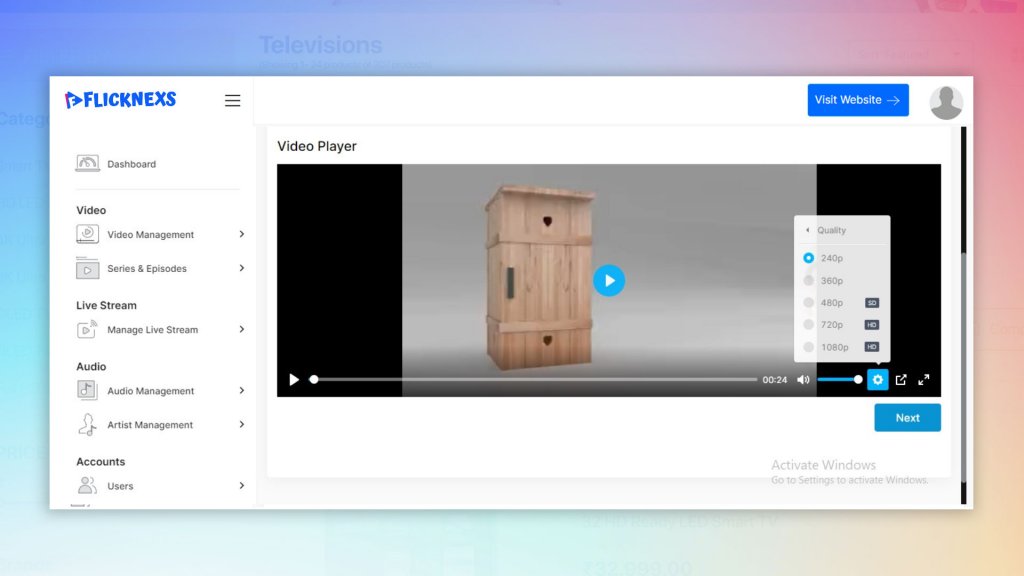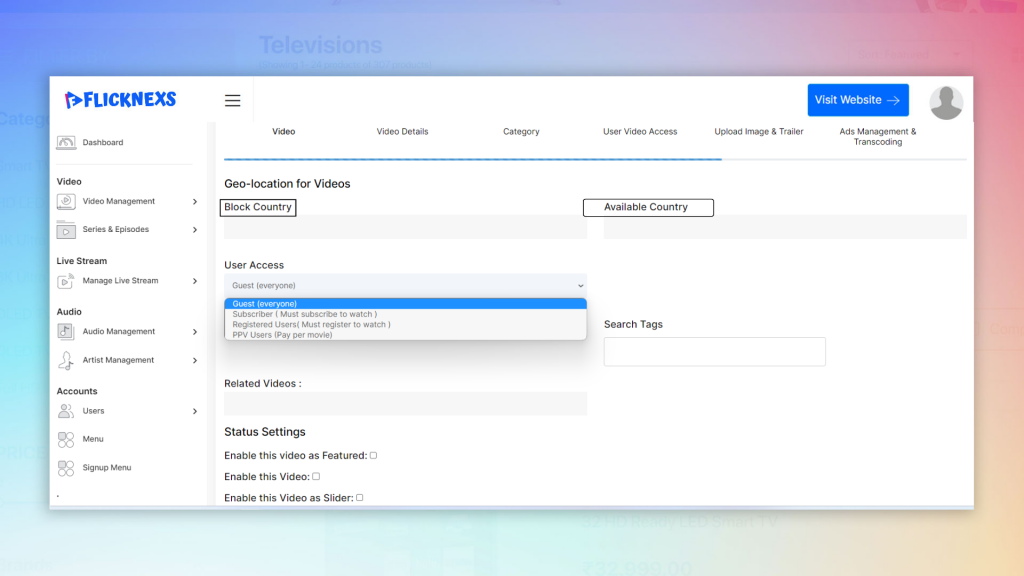Introduction
The world has shifted to a digital age where everything is available online. Online streaming software is one such technology that has revolutionized the entertainment industry. In this article, we will explore the definition of online streaming software, its brief history, and its importance in today’s digital age.
Definition of Online Streaming Software
Online streaming software is a technology that allows users to watch or listen to multimedia content, such as movies, TV shows, music, and live events, over the internet. The content is delivered in real-time or near real-time, and users can watch or listen to it on their devices, such as smartphones, tablets, laptops, or smart TVs, without downloading the entire file. The software uses a streaming protocol, such as HTTP, RTMP, or HLS, to deliver the content.
Types of Online Streaming Software
Live streaming software
Live streaming software allows users to broadcast live content over the internet, whether it’s a concert, a sports game, or a live event. Some popular examples of live streaming software include Flicknexs, Webnexs, Facebook Live, YouTube Live, and Twitch.
Definition and examples
Live streaming software enables real-time streaming of audio and video content over the internet. Some popular examples of live streaming software include Flicknexs, Webnexs, brightcove, Dacast, Muvi.
Features and functionalities
Live streaming software allows users to engage with their audience in real-time through chat and comments. It also provides users with features like live polls, Q&A sessions, and screen sharing.
Pros and cons
The pros of live streaming software include its ability to provide real-time engagement with the audience, generate immediate feedback, and build a sense of community. However, the cons include its reliance on stable internet connectivity and the need for high-quality audio and video equipment.
On-demand streaming software
On-demand streaming software allows users to watch pre-recorded content at their convenience, whether it’s a movie, a TV show, or a documentary. Some popular examples of on-demand streaming software include Flicknexs, Webnexs, Vplayed, Brid.tv, uscreen.tv.
Definition and examples
On-demand streaming software allows users to watch pre-recorded content at their convenience. Some popular examples of on-demand streaming software include Flicknexs, Webnexs, Dacast, Muvi, Kaltura
Features and functionalities
On-demand streaming software provides users with features like pause, rewind, and fast forward, allowing them to watch content at their own pace. It also provides users with personalized recommendations based on their viewing history.
Pros and cons
The pros of on-demand streaming software include its convenience, wide selection of content, and personalized recommendations. However, the cons include the need for a stable internet connection, subscription fees, and limited content availability based on region.
Hybrid streaming software
Definition and examples
Hybrid streaming software is a type of online streaming software that combines features from both live and on-demand streaming software. It allows users to stream live content while also having the ability to access pre-recorded content on demand. Examples of hybrid streaming software include Flicknexs, Webnexs, DaCast and StreamShark.
Features and functionalities
Hybrid streaming software provides users with features like Stream live events, Store and access pre-recorded content, Customizable player, Analytics, Monetization options.
Pros and cons
The pros of Hybrid streaming software include Flexibility, Customization, Analytics, Monetization. However, the cons include Cost, Complexity, Bandwidth requirements.
How Online Streaming Software Works
Overview of the online streaming software process
Online streaming software works by transmitting video and audio data over the internet to users who are watching or listening in real-time. The process typically involves three main steps:
Encoding
The video and audio content is compressed into a format that can be easily transmitted over the internet. This process is known as encoding and involves using specific codecs to compress the data.
Transmission
Once the content has been encoded, it is transmitted over the internet to the end-user. This can be done using a variety of protocols, which we’ll discuss in more detail in the next section.
Decoding
The end-user’s device receives the transmitted data and decodes it back into a video and audio format that can be played on the user’s device.
Streaming protocols and codecs
The two main protocols used for streaming are HTTP and RTMP. HTTP (Hypertext Transfer Protocol) is the protocol used for transmitting data over the World Wide Web. It is commonly used for on-demand streaming, as it is reliable and can be easily scaled to handle large amounts of traffic. RTMP (Real-Time Messaging Protocol) is a protocol specifically designed for live streaming. It allows for low latency and high-quality streaming, making it ideal for live events.
Codecs are used to compress and decompress video and audio data. The two most commonly used codecs for streaming are H.264 and AAC. H.264 is a video codec that is widely used for streaming due to its high compression rates and compatibility with a variety of devices. AAC (Advanced Audio Coding) is an audio codec that provides high-quality audio while also using less bandwidth than other codecs.
Factors affecting streaming quality
Several factors can affect the quality of streaming, including:
Bandwidth
Streaming requires a lot of bandwidth, so users with slower internet connections may experience buffering or poor quality video and audio.
Device compatibility
Different devices may have different capabilities, which can affect the quality of the streaming experience. For example, older devices may not support the latest codecs or may have slower processors that can’t handle high-quality streaming.
Network congestion
When multiple users are streaming at the same time, it can put a strain on the network and affect the quality of the streaming experience for everyone.
Best practices for optimal streaming performance
To ensure optimal streaming performance, it’s important to follow best practices, including:
Use a reliable streaming platform
Choose a streaming platform that can handle the amount of traffic you expect and provides the necessary features for your streaming needs.
Optimize your encoding settings
Use the appropriate encoding settings for your content to ensure the best quality while minimizing bandwidth usage.
Monitor your network and bandwidth usage
Keep an eye on your network and bandwidth usage to ensure that you have enough bandwidth to handle the amount of streaming traffic you expect.
Test your stream before going live
Always test your stream before going live to ensure that everything is working properly and that your viewers will have a good experience.
Key Features to Look for in Online Streaming Software
In today’s digital age, online streaming software has become an essential tool for businesses and individuals alike. Whether you are a content creator, an event organizer, or a marketer, the right online streaming software can help you reach a wider audience and engage with them more effectively. However, with so many options available in the market, choosing the right one can be a daunting task. To make things easier for you, we have compiled a list of key features that you should look for in online streaming software.
Video quality and resolution
One of the most important features of online streaming software is the quality of the video output. The software should be able to stream videos in high definition (HD) or even 4K resolution, depending on your needs. It should also support different video formats, such as MP4, AVI, or MOV, to ensure compatibility with different devices and platforms.

Support for multiple devices and platforms
Online streaming software should be able to stream content across multiple devices and platforms, such as desktops, laptops, tablets, and smartphones. It should also be compatible with different operating systems, such as Windows, macOS, iOS, and Android. This ensures that your audience can access your content regardless of the device they are using.
Customization and branding options
Online streaming software should allow you to customize the look and feel of your stream to match your brand’s identity. This includes the ability to add your logo, customize the player’s color scheme, and choose from different templates and themes.
Security and content protection
Online streaming software should have robust security features to protect your content from unauthorized access or piracy. This includes secure streaming protocols, such as HTTPS and DRM, as well as the ability to restrict access to certain viewers or regions.

Analytics and reporting tools
Online streaming software should have built-in analytics and reporting tools that allow you to track viewer engagement, audience demographics, and other key metrics. This helps you optimize your content and improve your overall streaming performance.

Ease of use and user interface
Online streaming software should be easy to use and have an intuitive user interface that allows you to set up and manage your stream with minimal hassle. It should also have a user-friendly control panel that allows you to monitor your stream’s performance in real-time and make adjustments on the fly.

Popular Online Streaming Software and Their Features
Flicknexs
Flicknexs is a popular online streaming software that offers a range of features and functionalities to help you stream your content seamlessly. Here are some of its key features:
- Live and on-demand streaming
Flicknexs supports both live and on-demand streaming, allowing you to stream your content in real-time or make it available for viewing at a later time.
- Multi-device support
Flicknexs is compatible with a wide range of devices, including desktops, laptops, tablets, smartphones, and smart TVs. It also supports different operating systems, such as Windows, macOS, iOS, and Android.
- Customization and branding options
Flicknexs allows you to customize your streaming player with your own logo, color scheme, and other branding elements. It also offers a range of templates and themes to choose from.
- Security and content protection
Flicknexs uses secure streaming protocols, such as HTTPS and DRM, to protect your content from unauthorized access or piracy. It also offers geo-restriction and password protection features to restrict access to your content.
- Analytics and reporting tools
Flicknexs provides detailed analytics and reporting tools that allow you to track viewer engagement, audience demographics, and other key metrics. This helps you optimize your content and improve your overall streaming performance.
- Monetization options
Flicknexs allows you to monetize your content through different revenue models, such as pay-per-view, subscription, or ad-supported. It also offers integration with different payment gateways, such as PayPal and Stripe.
- Easy-to-use interface
Flicknexs has a user-friendly control panel that allows you to manage your stream, monitor performance in real-time, and make adjustments on the fly. It also provides step-by-step guides and tutorials to help you set up and use the software.
Webnexs
Webnexs is an online streaming software that provides businesses with a platform to host and broadcast live video content to their audiences. The software comes equipped with various features that enhance the user’s experience.
Some of the key features of Webnexs online streaming software are:
- Live streaming
The software enables businesses to broadcast live events such as webinars, conferences, product launches, and other events in real-time.
- Video-on-demand
The software allows businesses to upload pre-recorded videos and make them available for their audience to watch on-demand.
- Monetization
Webnexs provides businesses with various monetization options, including pay-per-view, subscription-based models, and advertising.
- Customization
The software allows businesses to customize their streaming platform with their branding, including logos, color schemes, and themes.
- Analytics
Webnexs provides businesses with analytics tools to measure their audience’s engagement, such as viewership numbers, watch time, and demographics.
- Security
The software ensures the security of the content being streamed, including SSL encryption, DRM protection, and secure login credentials.
- Compatibility
Webnexs is compatible with various devices, including desktops, laptops, tablets, and smartphones, allowing businesses to reach their audience on multiple platforms.
How to Choose the Best Online Streaming Software for Your Needs
Assess your streaming goals and requirements
Before selecting an online streaming software, assess your streaming goals and requirements. What type of content do you want to stream? Do you need live or on-demand streaming? What devices and platforms do you want to support? Answering these questions will help you identify the features and functionalities you need.
Consider your budget and pricing options
Online streaming software can vary in price, so consider your budget and pricing options. Some software offers a one-time fee, while others may require a monthly subscription or charge based on usage. Consider what you can afford and what pricing model works best for your needs.
Read reviews and compare features
Read reviews and compare features of different online streaming software options. Look for software that has positive user reviews, high ratings, and the features that meet your needs.
Test out free trials or demos
Many online streaming software options offer free trials or demos. Take advantage of these to test out the software and see if it meets your needs before committing to a purchase.
Seek advice and recommendations from experts or peers
Finally, seek advice and recommendations from experts or peers. Ask for recommendations from others in your industry who have experience with online streaming software, or consult with experts who can provide guidance based on your specific needs.
Conclusion
In today’s digital age, online streaming software has become an essential tool for businesses, content creators, and individuals to share their content with a global audience. From live streaming events to on-demand video content, there are many options to choose from. It’s important to assess your goals and requirements, compare features and pricing, read reviews, and test out free trials or demos before making a final decision. With the right online streaming software, you can provide high-quality content to your audience, expand your reach, and achieve your streaming goals.



Leave a Reply